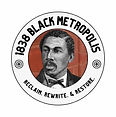In 1842 Hetty Reckless built a shelter in Philly for Black Women
- Michiko

- Jul 16, 2023
- 3 min read
Updated: Aug 13
Besides having the most powerful 19th century name I've ever heard, Hetty Reckless was a hero.
Yesterday, we stood at 7th and Lombard and bought Hetty back to life. Historical Reenactor Leslie Bramlett created a period authentic kit with Hetty in mind and then told Hetty's story in the first person to the tour participants.
As Hetty, Leslie led us through the pouring of libations in the heart of the Black Metropolis. It was incredible.
Hetty's Story
As an enslaved person in Salem, New Jersey (note that she was also called 'Amy', and 'Hester'), she got beat up a lot by the enslaver's wife. The fact was that the enslaver's mother had said on her deathbed that Hetty was to be freed when she died. But that wasn't in writing. When the mother died, the son, Robert Johnson, kept Hetty enslaved. And Johnson's wife hated Hetty, abusing her constantly. In fact, she knocked out her two front teeth.
One day in 1825, Hetty got on a stagecoach and took the 60 mile journey with her baby into Philadelphia - essentially freeing herself. She was unable to bring her older child, a girl, but it seems that later in life they reconnected in Philadelphia.
She immediately found the Pennsylvania Abolition Society and they sent a note back to her enslaver essentially communicating that a) we have Hetty's back and b) we have a case against you.

Hetty went on to be an active member of the both the Pennsylvania Female Anti-Slavery Society (PFASS) and the Female Vigilant Committee (FVC). PFASS fought slavery from a policy and legal perspective. FVC was on the ground helping freedom seekers make it to safety and establish lives once they arrived.
Even though PFASS had both Black and white members, Hetty was the only member who had experienced enslavement.
Hetty navigated between many worlds. As the only formally enslaved person in the PFASS, she navigated class and colorism among Black members and biases even with well-meaning white members. She played the important role of ensuring that monies from PFASS made it to freedom seekers that FVC was assisting.

Then, she and Hetty Burr worked with the Moral Reform Movement to open the Moral Reform Retreat at the corner of 7th and Lombard. This was a shelter conceived and run by Black women for Black women in 1842. On the books, it was built to help women leave prostitution and gain sobriety. So in way, the Moral Reform Retreat was what we would call 'rehab' today. But off the books, the Moral Reform Retreat also functioned as a shelter for freedom seekers, as a place for women to land when they escaped enslavement.

Womans societies were opening up in Philadelphia in the mid-1840s to combat prostitution and addiction. But they were limited to white women. The most famous was the Magdalen society. The Madgalen approach was heavy on the idea of deference to the rescuers and corrective discipline. Burr and Reckless' approach was more compassionate, with less judgement and more connection. (Haynes, 2009).

Over 200 women were assisted by the Moral Reform Retreat.
The Moral Reform Retreat also had a school for children and adult reading classes. William Still went there to improve his penmanship when he first came to Philly.
More Important Than We've Been Told
On the way home from the tour Leslie pointed out to me that Hetty is in a lot of sources. Martin Delaney mentions her in a letter to Frederick Douglass, the 1847 Friends Journal describes meeting her, she is called out in Smedley's History of the Underground Railroad in Chester County, she is listed in PFASS meeting and convention notes, she is listed in FVC meeting notes. The Inquirer wrote her obituary.
It's unusual for a Black woman in the 19th Century to show up in so many documented ways. She must have had a great reputation and been known by a lot of people.
Why then haven't we heard more about her? We hear a lot about Lucretia Mott but Hetty did as much work as Mott and maybe more. She lived her early life in enslavement, and courageously secured her own freedom. She wasn't in one abolitionist group, she was a leader in two. And she built physical infrastructure to save the lives of hundreds of women.
Let's start lifting her up!
Sources
Salem County Historical Society
HSP, Pennsylvania Abolition Society, Series 4, Box4B
Smedley History of the Underground Railroad
Borome The Vigilance Committee
April Rose Haynes - Riotous Flesh
Gayle Tate - Free Black Women in the Antebellum North
William Still’s Underground Railroad
Shirley Yee, Black Women Abolitionists: Study In Activism, 1828-1860
The North Star, Friday, March 9, 1849
A Friday Afternoon in Moyamensing, Friends Journal, 1847




